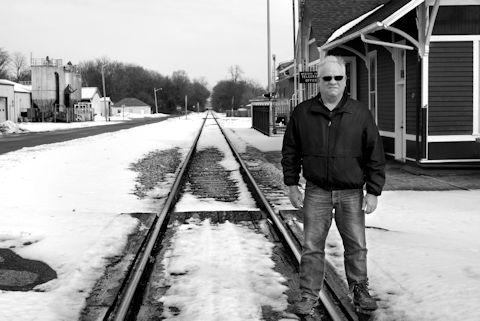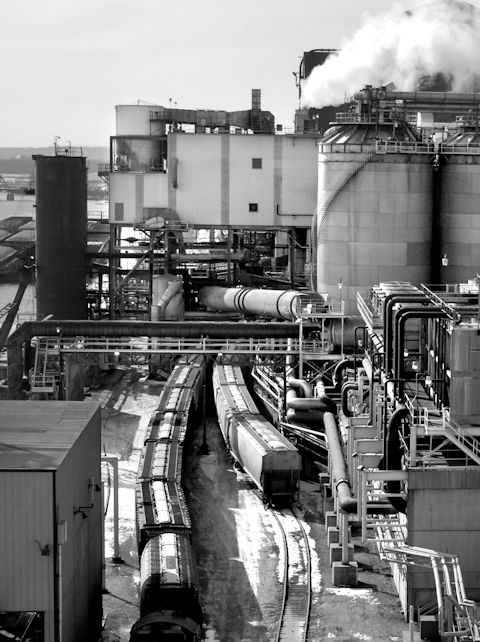
Peoria County Board member Jim Fennell, straddling the track running through Chillicothe, said he’s accustomed to the noise of freight in the area but would consider formation of a “quiet zone” depending on cost and resident interest.
Pictures rattle on the walls and plates shake in the cabinets at Joann and Galen Siscoe’s home a dozen times each day when freight trains pass on the tracks about 75 feet from their front door.
The couple has lived on Poplar Lane off Galena Road in Peoria for 40 years. In the beginning, one train a day traveled south and one north, never at night. The couple said a dozen trains go by night and day now, some with multiple locomotives and nearly 100 cars. Worse than the vibration is the train horn. Some engineers toot the horn in short spurts. Some lay on the horn in a steady blast reverberating up and down the river bluffs. There was one derailment a dozen years ago that trapped the Siscoes in their home for several days.
Freight volume through Peoria is climbing and one close observer projects continued increases of about 14 percent a year. Some freight is highly flammable. Former U.S. Secretary of Transportation Ray LaHood said city and county government can work on mitigation of noise and increasing safety.

Tanker cars carrying ethanol from the Archer Daniels Midland Peoria facility travel north along the Illinois River. The Iowa Interstate Railroad connects Peoria on track running along the river to Bureau, LaSalle and Chicago.
No one along the west shore of the Illinois River between Peoria and Chillicothe is buffered from train noise and safety concerns. People have different coping methods. A sound machine creating “white noise” runs every night when Bob Renner and his wife sleep. They have relied on “white noise” for more than 20 years to block out the blast from freight trains 200 feet from their home on Riverview Road near the Caterpillar Inc. Mossville facility. Outside activities around the Renner home are more problematic.
“It’s very loud. VERY loud. It’s like a car on the highway with the horn blaring,” Renner said. “We don’t live on a busy intersection. Maybe 12 houses in our area. Some trains toot but others leave it on.”
As rail freight volume increases across the country, the friction between commerce and homeowners is growing. Exacerbating the problem is a 2006 law calling for louder and longer horns. Recently, changes in Chicago eased congestion so more trains are moving through the state.
Galesburg, 47 miles west of Peoria, hit on a solution.
With up to 250 trains a day passing through the city, residents were up in arms. Galesburg worked to establish two “quiet zones” with a third zone recently approved. In designated quiet zones, train engineers no longer routinely sound horns at every crossing but use horns only in emergencies.
“Galesburg is relatively flat, and there was no relief from the noise,” said Wayne Carl, engineer with the city. “People couldn’t sleep. They could no longer enjoy their backyards. They were no longer putting money into their homes, and downtown merchants were not developing upper stories.”
Now residents hear the rumble but not the horn when trains go through town.
“An incredible difference,” Carl said. “People have their sanity back.”
To qualify for quiet zones, municipalities must evaluate and upgrade crossings where railroad tracks pass over roads. A constant warning system and crossing gate arms are needed and some roads may need to be merged with nearby crossings.
“Any community can request a quiet zone. One of the requirements is the zone must be at least one mile,” Carl said, noting that the federal office with oversight has been inundated with requests from communities wishing to implement quiet zones.
Total costs for the work in Galesburg was about $2.6 million, with about 10 percent covered by the railroad companies, 50 percent by the Illinois Commerce Commission and the remainder from Galesburg TIF funds.
When he was still in office, LaHood worked with former U.S. Rep. Dennis Hastert on quiet zones for Chicago suburbs.
In a recent interview, LaHood said $8 billion has been put into rail during Barack Obama’s presidency.
“That would never have happened without Obama’s vision,” LaHood said.
Freight companies are not legally required to disclose hazardous commodities they transport, however, LaHood said, “Communities should be informed, not every citizen, but there must be cooperation between the industry and first responders.”
Peoria County board member Jim Fennell is a volunteer fireman in Chillicothe. He said the department was informed when highly flammable vinyl chloride was transported through Chillicothe.
Fennell said people who buy homes near railroad tracks should realize noise and vibration come with the location.
“People make choices. It’s like moving to the country next to a farm and then complaining about the smell of manure,” Fennell said.
His priority is investing available resources to improving the safety of the viaduct under railroad tracks on Route 29 where he has responded to several accidents over his 45 years with the fire department. However, he said he’ll keep an open mind.
“I could support quiet zones that do not inflict inflated cost on the railroads. Obviously, taxpayers will foot some of the bill, but ultimately safety is a consideration,” he said.
Patrick Urich, Peoria city manager, said most rail traffic in and out of Peoria is along the river and the city would look at quiet zones if enough residents expressed interest.
“When I was in Lake County, a rapidly suburbanizing collar county of Chicago, there was quite a bit of concern over rail traffic,” Urich said. “The trains were very loud running through that community, and the public raised this issue. If there is an issue here, we would look into it.”
Some residents of Chillicothe said they’ve lived near the tracks so long, they’re used to the sound and are no longer disturbed by it. Greg and Diane Anderson bought their home on Riverview Road in Chillicothe two years ago and saw the yard abutted the tracks.
“When we first moved in, yea it woke me up, but most engineers are pretty good about backing off on the horn after 9 at night,” Greg Anderson said. “Right now, I’m at peace with it. If we started seeing a lot more trains each day, maybe my opinion would change.”
Diane Anderson said, “It still wakes me up, but I like trains. My dad is a big train fan so I don’t mind it.”
David Jordan, a train enthusiast and blogger (www.Peoriastation.com), said freight traffic through Peoria is down dramatically since its peak in the 1960s but is starting to climb.
“There are a lot of variables, but volume could increase about 14 percent a year,” Jordan said.
Freight through Peoria is primarily heavy equipment, ethanol and alcohol, coal, steel, chemicals and agricultural products like fertilizer.
Trains through Peoria travel at reduced speeds, reducing the risk of derailments. Two train derailments occurred in other states in recent weeks, one north of Dubuque, Iowa, spilling an estimated 30,000 gallons of ethanol into the Mississippi River. Eleven cars left the track, three cars caught fire and three plunged into the river, a source of drinking water for towns downstream. The other derailment in West Virginia involved 25 cars of a 109-car CSX train carrying crude oil from Bakken Shale in North Dakota to a refinery in Yorktown, Va. Explosions and fireballs resulted in a nearby house burning and the evacuation of a village. In this case, also, the leaked fuel spilled into a waterway that is the source of drinking water for communities downstream.
Michael Williams, vice president of communications for Genesee & Wyoming Railroad Services that operates the Tazewell & Peoria Railroad, said carload volume is increasing but he declined to give specific figures or content information. In a prepared statement he wrote “G&W railroads are always willing to take part in quiet zone discussions and cooperate in the process,” however in the 41 U.S. states where G&W operates, he is aware of only one municipality that created a quiet zone.
Williams said his company is in close communication with emergency first responders and provides training sessions for the commodities transported through Peoria.
A spokeswoman for Iowa Interstate Railroad that connects Peoria with Chicago said she would not answer specific questions and their public disclosures can be found on their web site.
